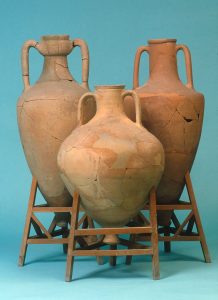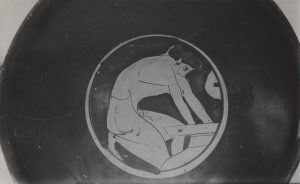Storage
Emily Laffin

© Hellenic Ministry of Culture & Sports / Organization for the Management and Development of Cultural Resources (Ο.Δ.Α.Π.).
Storage vessels with elaborate designs and relief images were produced in ancient Greece to be used in funerary, social, and economic contexts. But rather than being inspired for such occasions, their shapes and sizes express the importance of their use for food, its consumption, and storage. Greek vessels thus had many more uses than just as art pieces. The pithos was a courseware storage vessel that had similar features to an amphora (used for liquids) with its high neck and handles, but it was often much larger in size and could store much more than the standard amphora. The basic purpose of a pithos was to store wine, oil, grain, and other types of food. Most commonly they were created from clay, which was an ideal material for keeping out water, dirt, and any outside pests. Since these vessels were intended for food storage, however, the outer appearance of the vessels was of secondary importance. Decoration was either simple or non existent. The borrowing of the amphora shape for pithoi can easily be explained by the fact that both are storage vessels, but the pithos was meant to be utilized for storage only, whereas the amphora could be formed and designed according to what its intended function would be: transportation, storage, or serving.
Was an area of the home designated for storage? Nicholas Cahill notes that most Greek houses had two storeys, and could include specialized types of rooms such as a kitchen complex, or rooms used for symposia or other purposes. This begs the question whether there may have been rooms that were entirely dedicated to food storage. Since spaces in the household were used in various different ways (see chapter 4), it is often impossible to guess the function of a room based on material evidence alone. Cahill, however, identifies a large number of houses at Olynthus that do in fact contain facilities and rooms meant for storing large quantities of food. These storerooms are most commonly identified by the large quantities of pithoi fragments.

Xenophon includes a description of such storage rooms in the house of the wealthy landowner Ischomachus in his Oeconomicus (9.3). He describes dry rooms for storing grain, cool rooms for wine, and well-lit rooms for items that require light. This drinking cup depicts a general storeroom with storage vessels, including an amphora, chests, and household equipment (grill, cooking pot, drinking ware).
The quantity and length of time that food was stored is also important to consider as this would directly affect the longevity of food storage in the household, and it was important to ensure that food would not run out or go to waste. Ancient Greek farmers aimed to keep anywhere up to a year’s worth of food supply on hand in the house at any time. Since families were encouraged to sell their entire stock of grain, as noted by Nicholas Cahill, keeping only enough of a year’s supply for personal household use, it suggests that it would have been possible for them to keep more. One of the main duties of the wife of the household was to oversee this storage and attend to it, by making sure that these provisions were not used up within the span of a month. Xenophon’s Oeconomicus notes that both indoor and outdoor tasks demand labor and attention. Since the man’s body was more capable of enduring the cold and heat, he would be responsible for the outdoor tasks while the woman was much less capable of such endurance, and would be assigned the indoor tasks, which included managing food storage (7.22).
The quantity of pithoi in a household also offers hints about the use of the structure they were stored in. For example, the storage capacity of five large pithoi within the Villa of Good Fortune was too great for a single common household. The pithoi alongside other supportive evidence suggests that the villa may have been a type of hotel. The size of a storage room and quantity of on hand stored vessels also points to the wealth and status of this household, and its ability to hold stored food in much larger quantities than the average household.
Other Facts About Pithoi

Since pithoi were much larger in size in comparison to other storage vessels, they were able to serve a wider range of purposes. Most other storage was above ground, but pithoi could be dug into the ground to keep items cool below the surface. The image shown on this red-figured kylix depicts a good example of how pithoi would have been buried up to the shoulder of the vessel and provides an indication of its size next to a person.
Since the size of a pithos could be large enough to fit an entire person inside, pithoi were also used by some communities as a funerary burial vessel rather than serving its intended purpose as a food storage vessel.
There are noticeable differences in storage capacity between houses located in two different regions of Olynthus due to the adoption of different economic strategies. Homeowners with greater wealth in the so-called villa section differ from homeowners located in the north hill area. Villa homeowners invested much more space and money into their storerooms and pithoi in order to maintain self-sufficiency with their household storage. Households located on the north hill with lower wealth would invest in more productive rooms and tools such as facilities for producing agricultural items (like olive oil), stonecutting, and cloth weaving. These houses were more tied to the commercial economy of the city and depended more on purchasing food from the market, rather than being able to match more self-sufficient households. Households that put more time and resources into production of goods therefore did not store perishables and would rely on acquiring them as needed.
Bibliography and Further Reading
- Cahill, Nicholas. 2000. “Olynthus and Greek Town Planning.” The Classical World 93.5: 497–515..
- Christakis, Kostas S. 1999. “Pithoi and Food Storage in Neopalatial Crete: A Domestic Perspective.” World Archaeology 31.1: 1–20.
- Ebbinghaus, Susanne. 2005. “Protector of the City, or the Art of Storage in Early Greece.” The Journal of Hellenic Studies 125: 51–72.
- Giorgos Vavouranakis. 2014. “Funerary Pithoi in Bronze Age Crete: Their Introduction and Significance at the Threshold of Minoan Palatial Society.” American Journal of Archaeology 118.2: 197–222.

